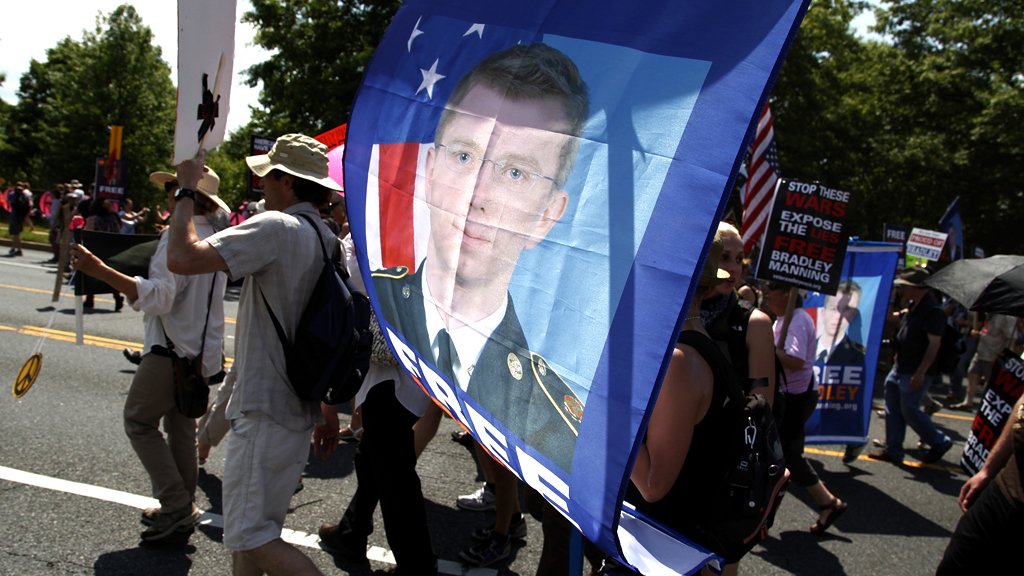What did WikiLeaks and Bradley Manning do for us?
As Bradley Manning stands trial in the US, Channel 4 News looks back at what the soldier’s leaks published by WikiLeaks revealed – and the impact they had.

For some, he is a symbol of human bravery and a courageous defender of human rights; for others, he is in breach of the estimable code of military ethics and an irresponsible traitor to the army.
What is not in dispute is that US Army Private Bradley Manning is the man behind the biggest leak of secret military data in history.
Weighing heavily on his slight shoulders are charges with hugely serious consequences. He has already been kept in military captivity for 1,100 days and faces 21 charges, ranging from “aiding the enemy”, which carries a life sentence, to violating the military’s computer rules.
Prosecutors have said that information leaked by Private Manning was seen by Osama bin Laden and will call a witness, believed to be one of the 22 US Navy Seals who killed Bin Laden in a raid in Pakistan, to testify. They argue that this was effectively giving intelligence to al-Qaeda.
Private Manning has pleaded guilty to some charges – namely to transmitting data to WikiLeaks between November 2009 and May 2010, while he was working as an intelligence analyst at Forward Operating Base Hammer outside Baghdad. This lesser offence carries a maximum sentence of 20 years.
But aside from the court case, the US soldier is at the centre of a debate about classified information in the digital age – and is caught in a battle between the US military and WikiLeaks, the organisation which appears to be faltering as its founder hides out in the Ecuadorian embassy in London.
And as controversial as the leaked information is, the reaction has been hugely varied. It was claimed by some that the leaks of diplomatic cables were nothing more than gossip, and that the war files only confirmed what we suspected anyway. While others, like security expert Glenn Greenwald, said it exposed “the breadth of the corruption, deceit, brutality and criminality on the part of the world’s most powerful factions”.
As the three month trial begins and the legal (and moral) battles get under way, Channel 4 News looks at some of the most significant revelations from Bradley Manning’s leak of almost 400,000 Iraq war files, 90,000 Afghan war files and 250,000 diplomatic cables in 2010.
Watch again: We ‘need to protect’ people like Bradley Manning

Collateral Murder
Dubbed “collateral murder” by WikLeaks, a secret video leaked by the organisation showed US air crew laughing after launching an air strike that killed a dozen people, including two Iraqis working for Reuters news agency. This was the first leak thought to be from Private Manning in April 2010 and showed that the US armed forces withheld information about how journalists and civilians died.
Citizen death toll
After years of being told that there was no record of the number of people killed in Iraq, information leaked by Private Manning led WikiLeaks to reveal that detailed accounts were kept after all.
We now know that of the 109,000 deaths logged over six years in Iraq, 66,081 were unarmed civilians. The London-based group Iraq Body Count said it identified around 15,000 previously unknown civilian deaths from the data contained in the leaked war logs.
As a result of the leaked war logs, Iraq Body Count identified around 15,000 previously unknown civilian deaths.
Torture
The Iraq war files also revealed evidence of the torture of detainees. The Bureau of Investigative Journalism and Dispatches analysed the 400,000 files and found over 300 classified reports alleging abuse by coalition forces on Iraqi prisoners, even after the Abu Ghraib scandal.
Reports detailed US soldiers and marines assaulting prisoners, forcing them to dig for home-made bombs and other mistreatments.
One incident was recorded in 2007: “Detainee stated he received the following abuse: 1) Jabbed with a screwdriver in the right side and upper back 2) Struck with cables and hoses in the arms, back, and legs 3) Electrocuted 4) Sodomised with a hose.”
Special report: Secret war files, from Afghanistan to Iraq
‘Blind eye’ to abuse
But as shocking as the torture itself, was information about how incidents of abuse by Iraqis were reported – but not investigated. The files appear to reveal that the US authorities failed to investigate hundreds of reports of torture, and even murder, by Iraqi police.
There appeared to be more than 1,300 individual cases of torture and abuse carried out by Iraqis on Iraqi prisoners at police stations and army bases.
The figures imply that coalition forces either witnessed or reported on themselves. Beatings, electric shock treatments, sodomy – all of it was recorded daily. But according to two military orders given to US troops after Abu Ghraib, troops were told they should report Iraqi-on-Iraqi abuse – but that if coalition forces were not involved, that “no further investigating will be conducted”.
Child abuse in Afghanistan
Leaked diplomatic cables showed that US defence contractor DynCorp was complicit in child trafficking activities, and had boys, obtained by child traffickers, for entertainment at a party for Afghan security recruits.
The revelation has contributed to calls for US defence contractors to be removed from Afghanistan.
-
Latest news
-
Boy with profound learning disabilities reaches out of court settlement after abuse in residential school7m

-
India election: Modi rivals hit by string of raids and arrests7m

-
Can UK’s abandoned mines be used to build a greener future?5m

-
Sycamore Gap: Man pleads not guilty to felling iconic tree2m

-
‘Child poverty has not fallen since Tories came in’, says Gordon Brown5m

-




